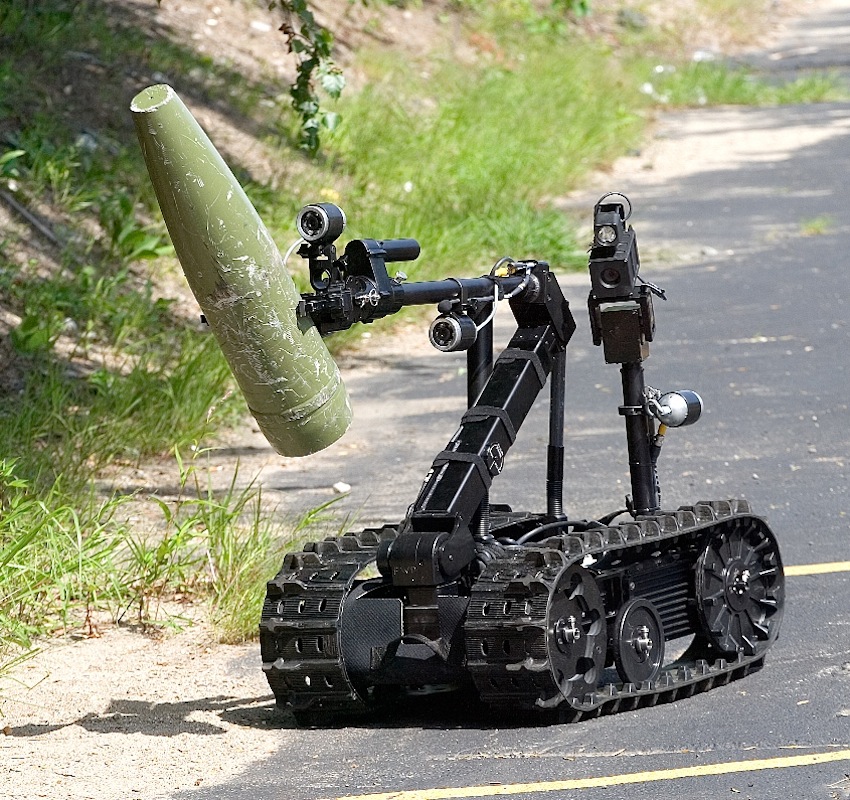Waltham-Based Robotics Company Lends ‘Arm’ During Bomb Searches
Before the brave men and women of local law enforcement moved in to clear the crime scene in Watertown, after a brazen shootout with marathon bombing suspect Tamerlan Tsarnaev, they utilized the help of locally manufactured robots to make sure there were no immediate bomb threats in the area.
The “tactical robots” came from the Waltham offices of manufacturer QinetiQ, a British company with divisions in the U.S., which works closely with law enforcement agencies and bomb squads, and is the foremost supplier of military robotics designed to help personnel and first responders “stay out of harm’s way.”
Dozens of the robots were used throughout the four-and-a-half day time span—from when the bombs first went off on the Marathon route, until the eventual capture of Dzokhar Tsarnaev—to help investigate suspicious activity in the areas that the local and federal bomb squads were scouring. Those tactical robots were produced here in the States, and primarily came from the robotics division in Waltham.
One of QinetiQ’s featured robots, the Talon, checked the trunk of the car abandoned by the Tsarnaev brothers during the late-night gun battle on the streets of Watertown, and piqued viewers’ curiosity after being featured on newscasts across the country. The wheeled device rolled onto the scene after the intense standoff ended, and used its mechanical arms to open the trunk and hood of the vehicle to allow the officials to see what was inside via the camera attached to its body.
“The TALON robot that approached the suspicious car early on Friday morning after the shootout, was equipped with standard day/night cameras and a manipulator arm. The TALON’s radios allowed the operator to remain at a safe distance while he used the robot’s many cameras to closely examine the car and its surrounding area,” says Charlie Dean, QinetiQ’s director of business development within the unmanned systems group. “The manipulator arm on the robot can be used to open the doors and trunks on vehicles, and the cameras on the arm can then be used to look inside these spaces that were just revealed and see if there are explosives inside. These two brothers were clearly using explosives.”
When police began the week-long search for the suspects behind the bombings, QinetiQ activated a 24-hour operation in case customers needed to take the robots out of Boston for quick repair. Dean says their deployment of other tactical robots was at the ready, too, so they could “back up operations in the city whenever, wherever needed.” They were also at the ready as investigators closed in on Suspect 2, Dzokhar, as he hid in a boat in a Watertown resident’s backyard.
Besides the Talon, the company had loaded up its larger robots, including the tractor-sized “Sparticus,” which Dean explains is like a Bobcat tractor that’s transformed into “an optionally manned robotic vehicle,” simply by fastening one of the company’s “kits” to the vehicle magnetically. “Once it’s a robot you can send the Spartacus up to a couple of miles from your location. With the wide variety of tools available for Bobcat loaders, the Spartacus robot has incredible capability…they call it the ‘Minotaur’ in the Army…it’s used for mine rolling ahead of dismounted patrols.”
Dean says QinetiQ has been on the scene of many other harrowing situations prior to the recent Boston attack. In the 1990s, the company was the first to unleash their robots into combat in Bosnia. More than a decade later, their devices were employed during the search through rubble at the site of the September 11 attacks in New York City. Many of those tactical robots remain on scene today, says Dean. They have even helped defuse between 20 to 30,000 IED’s in Iraq and Afghanistan, since the U.S. first entered those countries. Dean says QinetiQ also answered the call of first responders following the devastating earthquakes in Fukishima, Japan. And in each of these cases, the company deployed specially trained employees along with the tactical robots. “It wasn’t the first time our robots were out there last week. Bomb squads all over New England have QinetiQ’s robots of different sizes as their habitual robot tools to approach dangerous threatening devices”, says Dean. The robot is a tool, an extension of the human…it allows the bomb squad to send the robot in first and protect the team while they investigate suspicious items and if required, neutralize a threat. For the military and for these domestic bomb squads—these brave, brave bomb squad technicians—to use these robotic tools and deal with these huge hazards saves so many lives.”
In the case with the Tsarnaev brothers, however, Dean says QinetiQ was glad to be of service during such an intense week. “We are very pleased to support our local economy as a global business with a major footprint in the Boston area that goes back over half a century. Last week…we were immensely proud to be there assisting the local first responders. But these responders and Federal agents are our real life heroes—they deserve a victory parade.”



